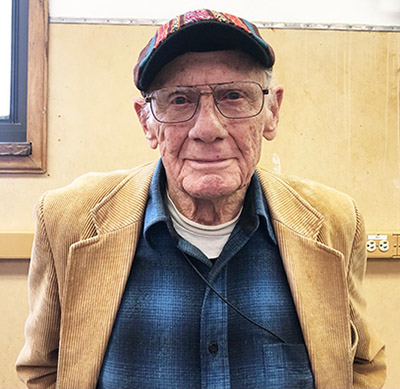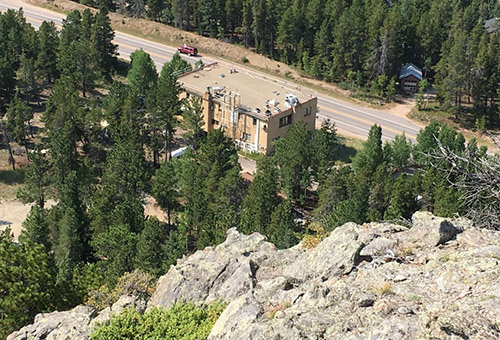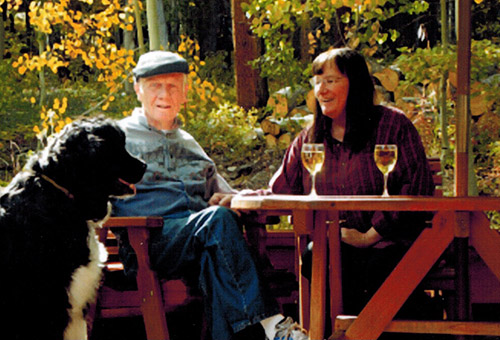A .gov website belongs to an official government organization in the United States.
A lock () or https:// means you've safely connected to the .gov website. Share sensitive information only on official, secure websites.
12 June 2020
written by Jeanne Waters, NOAA Chemical Sciences Laboratory

Several of us "old Aeronomy Labbers" received an email with the subject line "Clyde" on Thursday May 28. That alone is a tribute to the man – that when we opened and read the email saying Clyde had passed the day before, not one of us wondered, "Clyde who?"
Clyde Burnett was an Aeronomy Lab (and Fritz Peak Atmospheric Observatory) institution.
Before we became the Chemical Sciences Laboratory, before the Chemical Sciences Division, we were the Aeronomy Laboratory. A few of us from those days remain, here and scattered around the country and world, and we remember the old Aeronomy Lab days, and Clyde, with fondness.
As noted by George Mount, another former Aeronomy Labber (now retired from Washington State University and an Emeritus Professor at NASA Jet Propulsion Laboratory), "Well, that is the end of an era." He says, "Clyde was a professor at Florida Atlantic University (beginning in 1965) and spent most of his career there. However, early in the 1970s he became interested in hydroxyl chemistry in the upper atmosphere and built a PEPSIOS interferometer to measure the small atmospheric absorption of sunlight by hydroxyl. The PEPSIOS was a high spectral resolution interferometer utilizing three Fabry-Periot etalons in series."
If you want to read more about the PEPSIOS pilot model, there is a paper published by Julian Mack, Fred Roesler and others in Applied Optics in 1963. Both Clyde and Fred were students of Julian Mack. [J. E. Mack, D. P. McNutt, F. L. Roesler, and R. Chabbal, The PEPSIOS Purely Interferometric High-Resolution Scanning Spectrometer. I. The Pilot Model, Applied Optics, 2(9), 873-885, 1963].
As George said, "The hydroxyl molecule controls many aspects of atmospheric photochemistry and its abundance in the upper atmosphere can be estimated from column spectroscopic observation. Clyde realized that Florida was not a good location to make measurements and contacted John Noxon at the Aeronomy Lab to see if he could come to Fritz Peak and begin the measurements in 1977."



In her article about Clyde in The Mountain Ear, Sarah Haas says that the building "was originally built in the 1960s as a lodge for tourists, replete with a big wooden bar and dormitory style accommodations. Soon ... the building was converted into a laboratory, first by scientists at CU who'd come ... up to study the Aurora, and later by NOAA."
George noted, "Clyde's PEPSIOS OH measurements at the Peak were supported by the National Science Foundation for nearly 35 years, a long, long data record in which he applied himself diligently to taking data nearly every possible day and maintaining a long-term calibration on the same instrument all those years.
He and his then-wife, Betsy Beaver Burnett, were a husband/wife team who made the measurements and interpreted the observations to understand the HOx (hypochlorous and hypobromous acids) chemistry of the upper atmosphere. Clyde made the measurements and Betsy did analysis and put the data into a chemical scenario. George says, "We all remember Clyde sitting on that stool for hour after hour and using nitrogen to scan the system, watching carefully with his little magnifying glass to see if the scan was at a limit!" He continues, "Clyde reported on his results regularly at AGU meetings for many years through thick and thin. Some of his conclusions were controversial and the discussions usually revealed the more colorful aspects of Clyde. He was writing a summary paper of all his years of observations for publication when he passed. Time marches on!"
Ken Minschwaner, who as a Masters student worked with Clyde on OH at the Peak and went on to Harvard for his PhD, is now the Marvin H. Wilkening Professor of Physics at the New Mexico Institute of Mining and Technology. Ken told me of additional measurements I never knew about. He said that there is a ton of data from OH measurements Clyde made at Poker Flat, Alaska, and in Micronesia and New Zealand, in addition to his measurements from the FAU campus in Boca Raton, FL.
George told me a little about those Pacific island measurements in Truk (now Chuuk), Micronesia. It seems they always had trouble finding a place to stay. They ended up staying at a house of prostitution with all the “gear” in the room (mirrors, etc.) and always found that amusing.
I learned that Clyde was co-author on a book (Atomic and Nuclear Physics) published 1 January 1956. Ken said, "I knew about Clyde's old book on Modern Physics because the story goes that Betsy used it in one of her courses, and that's how she struck up a conversation after one of his talks. Interestingly, I took a course in modern physics from Clyde (1984) and we used (Paul A.) Tipler!"

As Ken also noted, in the last 20 or so years Clyde became very involved with climate issues. He wrote a monthly column for The Mountain Ear, posting his final column, Climate Conversations: After the Virus on May 15. In it he wondered, "Will climate change disappear? Will Earth or Human response change? Will family structure change after nine months?" He indicated that some social isolation practices will live on, and hoped that neighbors might plan cooperative grocery shopping, trips to farmers markets and some communal meals. He asked plaintively, "Will our new habits become the new human response to climate change?"
I remembered a book (The Greenhouse Effect: A Legacy) Clyde had brought in and autographed for me around 2007 or 2008, laughing as he let me in on the secret that very few people knew that he was the author, Alex Cook. When I looked further after hearing from Ken, "Alex Cook" had at least seven books (mostly fiction and involving climate change issues), finally fessing up to being Clyde Burnett in his last book, The Professor: Chronicles of a University Life published in 2019.


About Alex Cook, Amazon says: "Alex Cook is the pen name of Dr. Clyde R. Burnett, Emeritus Professor of Physics, Florida Atlantic University. He currently lives in the Colorado mountains near the NOAA Fritz Peak Atmospheric Observatory, where as a visiting scientist he secured 33 years of measurements of atmospheric hydroxyl, related to the problem of stratospheric ozone. He has recently given attention to the science of global warming and climate change. He presently writes the monthly column Climate Conversations for the Nederland, Colorado Mountain-Ear. The science is the subject of the non-fiction Nature's Greenhouse - Ominous Developments by Alex Cook and J. George. The atmospheric science is also embedded in each of the fiction books by Alex Cook."

Clyde loved dogs, especially Newfies. Ken Minschwaner remembers he had a big black Newfie named Gandy in the 1980's, and when he'd take him for walks in woods other hikers would sometimes mistake Gandy for a bear! George Mount says, "I do remember Gandy; man, he slobbered all over everything including Clyde and Betsy and he was huge."
For anyone interested in an excellent article about Clyde, I recommend The Mountain Ear Mountain Folk Tales column by Sarah Haas as it captures him pretty perfectly. Sarah writes not only about Clyde (his dog's hair is still stuck in the wheel of his office chair upstairs) but about Fritz Peak Atmospheric Observatory itself, noting that a few of the labs were "for lasers which, by Clyde's accounts, were just as exciting as they sound."
She notes that Clyde's 33-year series of OH measurements at Fritz Peak is "the longest data set in the world related to the ozone problem." In the article she and Wanda Sundquist, caretaker at Fritz Peak, go back and forth with Clyde about his piles of papers, destined for the recycle bin, asking if there isn't something he wants to keep. "It’s all published," he says, more than once.

Sarah leafs through the stacks of old papers, noting "The more I scrounge the more the smell of old libraries spews from the stacks and I'm overcome with a wave of nostalgia that can’t possibly belong to me because, with no computers in sight, this isn’t my world."
She reminds readers that in his monthly column, "Clyde writes to us imploringly, in no uncertain terms, begging us to pay attention to global warming and to do our part to combat climate change."
Clyde stops her as she's on her way out the door and says to her, "Climate change is a big problem. It’s the big problem. We need to do everything we can to fix it. We, each of us, need to be leaders."
"Are you optimistic then?" Sarah asks.
"No," he says, without giving it a second thought.
And there you have it. For Clyde, it didn’t matter that he thought the fight was already lost. He just kept on fighting, until he died on May 27. Ken says "I have a coffee mug from Clyde's 90th birthday celebration on 23 December 2013, so the evidence points to 96!"